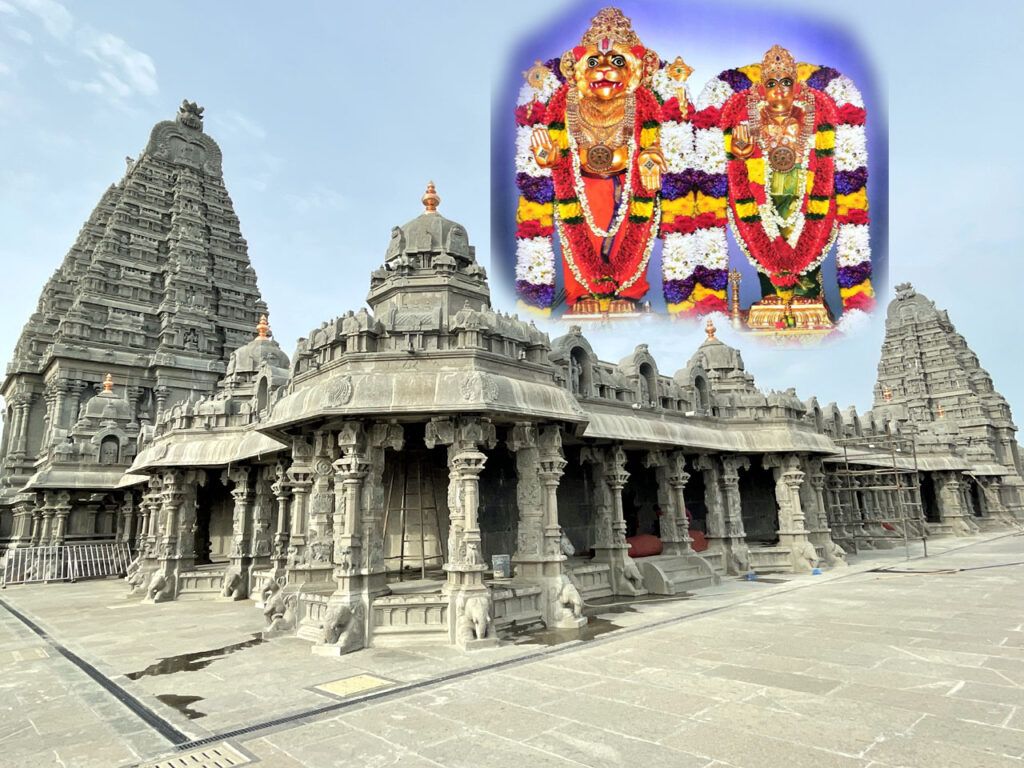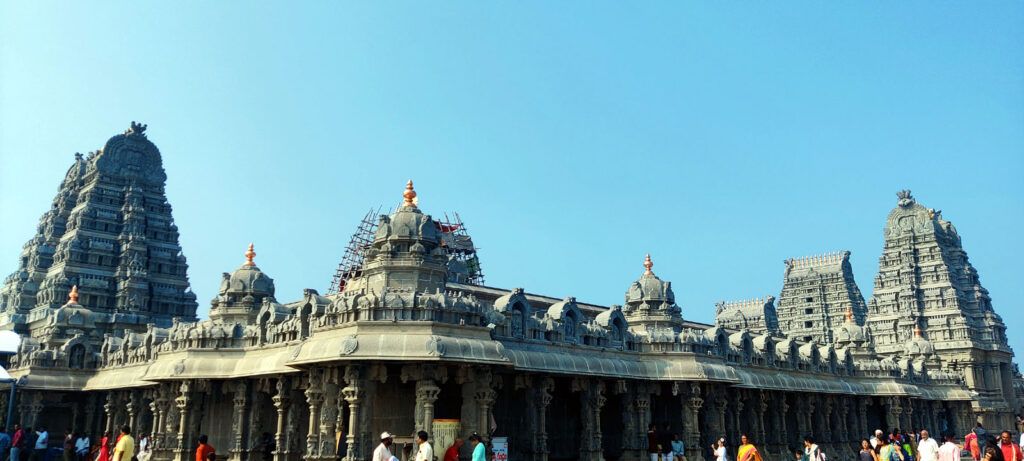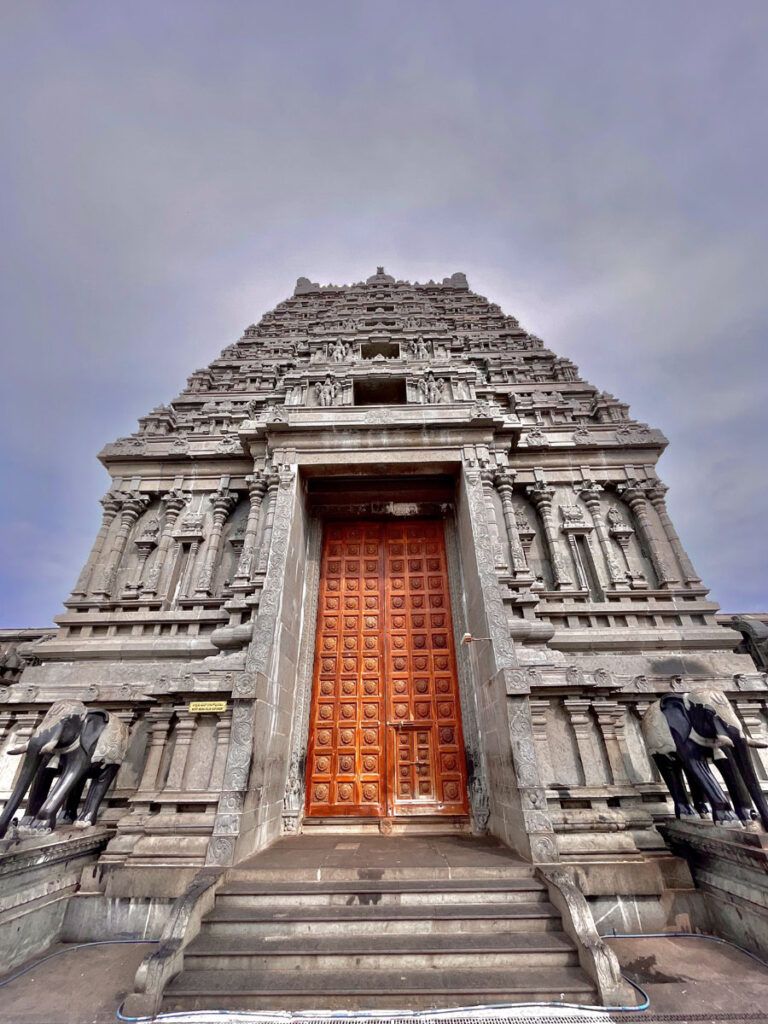Yadagirigutta Temple: Where Narasimha Comes Alive in 5 Forms
Yadagirigutta Temple is a Hindu temple dedicated to the deity Narasimha, a man-lion incarnation of Vishnu. It is located on a hilltop in the Yadagirigutta district of Telangana, India. The temple is known for its towering gopuram, or gateway tower, which is one of the tallest in India.

Contents
- 1 History of Sri Lakshmi Narasimha Swamy Temple:
- 2 Legend of Yadagirigutta Temple:
- 3 Significane of Yadagirigutta Temple:
- 4 Myths of Yadagirigutta Temple:
- 5 Architecture of Yadagirigutta Temple:
- 6 Specialty of Yadagirigutta Temple:
- 7 Yadagirigutta Temple Darshan Timing:
- 8 Places to visit near Yadagirigutta Temple:
- 9 Telangana Government Role:
- 10 FAQ:
- 11 How to Reach Yadagirigutta Temple:
- 12 Google Maps:
History of Sri Lakshmi Narasimha Swamy Temple:
The history of Yadagirigutta Temple is a long and rich one, dating back to the 13th century. The temple is dedicated to Lord Narasimha, a form of Vishnu, and is located on a hilltop in the Yadadri district of Telangana, India.
Here are some key events in the history of Yadagirigutta Temple:
- 13th century: The temple is founded by Yada, the son of the sage Rishyasringa.
- 17th century: The temple is renovated by the Kakatiya dynasty.
- 19th century: The temple is renovated by the Nizam of Hyderabad.
- 20th century: The temple is renovated by the Indian government.
- 21st century: The temple is renovated and expanded on a massive scale by the government of Telangana.
Read More>> Dwaraka Tirumala Temple: Sacred 11th Century Chinna Tirupati
Legend of Yadagirigutta Temple:
According to the legend, Yadagiri was a devout sage who lived in the forest. One day, he was meditating when he saw a vision of Lord Vishnu. The Lord told Yadagiri that he would appear on the mountain, and that a temple should be built in his honor.
Yadagiri followed the Lord’s instructions, and a temple was built on the mountain. The temple was dedicated to Lord Vishnu, and it became a popular pilgrimage destination.
Over the centuries, the temple has been expanded and renovated several times. The current structure dates back to the 17th century.
The legend of Yadagirigutta Temple is a reminder of the power of faith. It is a story of how a humble sage was blessed by the Lord, and how a temple was built to honor his devotion.

Here is a more detailed version of the legend:
Yadagiri was a sage who lived in the forest of Yadagirigutta. He was a devout follower of Lord Vishnu, and he spent his days meditating and praying to the Lord.
One day, Yadagiri was meditating when he saw a vision of Lord Vishnu. The Lord told Yadagiri that he would appear on the mountain, and that a temple should be built in his honor.
Yadagiri was overjoyed by the Lord’s vision. He immediately set to work building a temple on the mountain.
The temple took many years to build, but it was finally completed. The temple was dedicated to Lord Vishnu, and it became a popular pilgrimage destination.
Over the centuries, the temple has been expanded and renovated several times. The current structure dates back to the 17th century.
Read More>> 2500 Years Dwarkadhish Temple: Where Miracles Still Happen
Significane of Yadagirigutta Temple:
Yadagirigutta is significant for a number of reasons. First, it is believed to be the place where Lord Narasimha appeared to the sage Yadarishi in five different forms: Jwala Narasimha, Yogananda Narasimha, Gandabherunda Narasimha, Ugra Narasimha, and Lakshmi Narasimha.
Second, the temple is said to have healing powers. Many devotees come to Yadagirigutta to pray for relief from their illnesses. There are many stories of people who have been cured of their diseases after visiting the temple.
Third, Yadagirigutta is a place of spiritual significance. It is believed that the temple is located on a powerful energy vortex. Many devotees come to Yadagirigutta to meditate and seek spiritual guidance.

Myths of Yadagirigutta Temple:
The myth of Sage Yadarishi
According to Hindu mythology, a sage named Yadarishi was performing penance in the caves near the present-day temple. Lord Narasimha appeared before him and granted him several boons. The Lord then instructed Sage Yadarishi to install his idol in the caves for the welfare of humanity. The sage followed the Lord’s instructions, and the temple was built.
The myth of the five forms of Lord Narasimha
Lord Narasimha is said to have appeared to Sage Yadarishi in five different forms:
- Jwala Narasimha: This form is a fiery manifestation of Lord Narasimha. It is said to represent the Lord’s power and strength.
- Yogananda Narasimha: This form is a peaceful manifestation of Lord Narasimha. It is said to represent the Lord’s compassion and mercy.
- Lakshminarayana Narasimha: This form is a combined form of Lord Vishnu and Lord Narasimha. It is said to represent the Lord’s duality of power and compassion.
- Gandabherunda Narasimha: This form is a lion-headed bird manifestation of Lord Narasimha. It is said to represent the Lord’s protection and guidance.
- Ugra Narasimha: This form is a fierce manifestation of Lord Narasimha. It is said to represent the Lord’s wrath and justice.
The myth of the healing power of the temple
The Yadagirigutta Temple is said to have healing powers. Devotees believe that praying to Lord Narasimha at the temple can cure diseases and ailments. There are many stories of people who have been cured of their illnesses after visiting the temple.
The myth of the future of the temple
It is believed that the Yadagirigutta Temple will become one of the most important pilgrimage sites in India. The temple is currently undergoing a major renovation and expansion project. When the project is complete, the temple will be a sprawling complex with multiple shrines, temples, and other religious structures.
Read More>> Maa Mundeshwari Devi Temple: Unveiling 4th Century Secrets

Architecture of Yadagirigutta Temple:
The new architecture of Yadagirigutta Temple is a marvel of modern engineering and traditional Indian temple architecture. The temple is built entirely in stone and is adorned with intricate carvings and sculptures. The seven gopurams (gateway towers) of the temple are inspired by the Srirangam temple in Tiruchirapalli, Tamil Nadu. The main gopuram, the Vimana Gopuram, is plated with 100 kg of gold.
The temple complex is spread over 100 acres and includes several other structures, such as a prakaram (outer courtyard), a mandapam (hall), and a sanctum sanctorum (innermost shrine). The sanctum sanctorum houses the main deity of the temple, Lord Lakshmi Narasimha Swamy.
The new architecture of Yadagirigutta Temple has been praised for its beauty, grandeur, and attention to detail. The temple is a popular pilgrimage site for Hindus from all over India and the world.
Here are some of the key features of the new architecture of Yadagirigutta Temple:
- The temple is built entirely in stone, using traditional Indian construction techniques.
- The temple complex is spread over 100 acres and includes several other structures, such as a prakaram, a mandapam, and a sanctum sanctorum.
- The seven gopurams of the temple are inspired by the Srirangam temple in Tiruchirapalli, Tamil Nadu.
- The main gopuram, the Vimana Gopuram, is plated with 100 kg of gold.
- The temple is adorned with intricate carvings and sculptures depicting scenes from Hindu mythology.
- The sanctum sanctorum houses the main deity of the temple, Lord Lakshmi Narasimha Swamy.
Read More>> Pancharama Kshetras: Kartikeya Breaks the Shivalinga into 5

Specialty of Yadagirigutta Temple:
Yadagirigutta Temple is a Hindu temple dedicated to the god Narasimha, an avatar of Vishnu. It is located on a hillock in the small town of Yadagirigutta in the Yadadri Bhuvanagiri district of the Indian state of Telangana.
The temple is known for its following specialities:
- It is the only temple in the world that is dedicated to all five forms of Narasimha. The five forms are:
- Svayambhu Narasimha: This form is said to have appeared naturally in a cave on the hillock.
- Surya Narasimha: This form is said to have appeared to the sage Yadarishi in a vision.
- Vyuha Narasimha: This form is said to have appeared to protect the sage Yadarishi from the demons.
- Yogasana Narasimha: This form is said to be the form of Narasimha in meditation.
- Surya Bhujanga Narasimha: This form is said to be the form of Narasimha in combat with the demon Hiranyakashipu.
- The temple is built entirely of black stone. This is a rare feature in Hindu temples, which are typically built of white marble or sandstone.
- The temple is located in a beautiful natural setting. The hillock on which the temple is built is surrounded by lush forests and rolling hills.
- The temple is a popular pilgrimage destination. Millions of devotees visit the temple each year to seek the blessings of Narasimha.
In addition to these specialities, Yadagirigutta Temple is also known for its architectural beauty. The temple complex is spread over 1900 acres and includes a number of shrines, gopurams (towers), and other structures. The temple is also home to a number of religious and cultural institutions.
Read More>> Enchanting Beauty of Madurai Meenakshi Amman Temple
Yadagirigutta Temple Darshan Timing:
- Morning: The temple opens in the early morning hours, usually around 4:00 AM or 5:00 AM.
- Darshan Timings: Devotees can have darshan (viewing of the deity) from the early morning hours until around 12:00 PM.
- Temple Closure: The temple is closed for a few hours during the afternoon, typically from 12:00 PM to 4:00 PM.
- Evening: The temple reopens in the evening and remains open until 8:00 PM or 9:00 PM, allowing devotees to have darshan.

Places to visit near Yadagirigutta Temple:
Bhongir Fort: Bhongir Fort is located about 24 kilometers from Yadagirigutta. This historic hill fort offers panoramic views of the surrounding countryside and is known for its unique rock formations. You can also explore the fort’s architecture and historical significance.
Kunda Satyanarayana Kala Dhamam: This spiritual and cultural complex is located around 23 kilometers from Yadagirigutta. It features a beautiful temple dedicated to Lord Satyanarayana and is a serene place to visit.
Surendrapuri: Situated around 12 kilometers from Yadagirigutta, Surendrapuri is a unique theme park dedicated to Hindu mythology and Indian heritage. It features life-sized sculptures, replicas of famous temples, and various mythological exhibits.
Jainath Temple: Jainath Temple, dedicated to Lord Adinath, is located about 50 kilometers from Yadagirigutta. It’s an ancient Jain temple known for its intricate architecture and historical significance.
Basar Saraswathi Temple: If you’re interested in visiting a temple dedicated to the goddess of knowledge and wisdom, the Basar Saraswathi Temple is about 70 kilometers from Yadagirigutta. It’s a popular pilgrimage site, especially for students and scholars.
Alisagar Reservoir: Alisagar Reservoir is around 75 kilometers from Yadagirigutta and offers a picturesque environment for a relaxing day. You can enjoy boating and picnicking in the park surrounding the reservoir.
Nizamabad: Nizamabad, a historical city, is approximately 60 kilometers away from Yadagirigutta. You can explore its heritage sites, including Nizamabad Fort, Nizam Sagar Dam, and the Archaeological and Heritage Museum.
Pocharam Wildlife Sanctuary: This wildlife sanctuary is located about 90 kilometers from Yadagirigutta and is known for its diverse flora and fauna. It’s a great place for nature enthusiasts and birdwatchers.
Telangana Government Role:
The Telangana government has played a significant role in the development and renovation of the Yadagirigutta Temple. In 2016, Chief Minister K. Chandrashekhar Rao initiated a major renovation project for the temple, with a budget of ₹1800 crores. The project was completed in March 2022 and has resulted in the transformation of the temple into a world-class pilgrimage site.
The Telangana government has also provided a number of other benefits to the Yadagirigutta Temple, including:
- Increased funding for the temple’s operations and maintenance
- Development of new infrastructure and amenities for pilgrims, such as roads, parking facilities, and accommodation
- Promotion of the temple as a major tourist destination
- Support for the preservation of the temple’s cultural heritage
The Telangana government’s commitment to the Yadagirigutta Temple is a reflection of the importance that the temple holds for the people of Telangana. The temple is one of the most sacred Hindu sites in the state and attracts millions of pilgrims from all over India and the world each year.
Here are some specific examples of the Telangana government’s initiatives at the Yadagirigutta Temple:
- The government has acquired over 1900 acres of land around the temple to develop new infrastructure and amenities for pilgrims.
- The government has constructed a new temple complex with a grand gopuram (gateway tower), mandapam (pavilion), and sanctum sanctorum.
- The government has also constructed a new pilgrim center with dormitories, dining halls, and other facilities.
- The government has developed new roads and parking facilities to ease traffic congestion around the temple.
- The government has launched a number of promotional campaigns to highlight the Yadagirigutta Temple as a major tourist destination.
- The government has also established a Yadadri Temple Development Authority (YTDA) to oversee the development and management of the temple.
FAQ:
What is Yadagirigutta Temple?
Yadagirigutta Temple is a Hindu temple dedicated to Narasimha Swamy, an incarnation of Vishnu. It is located on a hillock in the Nalgonda district of Telangana, India. The temple is said to be over 1,000 years old, and it is one of the most important pilgrimage sites in South India.
What are the five forms of Narasimha Swamy worshipped at Yadagirigutta Temple?
The five forms of Narasimha Swamy worshipped at Yadagirigutta Temple are:
- Jwala Narasimha: A fiery form of Narasimha Swamy that is said to protect devotees from evil.
- Yogananda Narasimha: A form of Narasimha Swamy that is said to grant spiritual enlightenment.
- Gandabherunda Narasimha: A form of Narasimha Swamy that is said to protect devotees from natural disasters.
- Ugra Narasimha: A fierce form of Narasimha Swamy that is said to punish the wicked.
- Lakshmi Narasimha: A benevolent form of Narasimha Swamy that is said to bless devotees with prosperity and happiness.
How can I get to Yadagirigutta Temple?
Yadagirigutta Temple is located about 60 kilometers from Hyderabad, the capital of Telangana. There are several ways to get to the temple, including:
- By car: The temple is well-connected by road, and it takes about an hour to drive from Hyderabad.
- By train: There is a railway station at Raigiri, which is about 13 kilometers from the temple.
- By bus: There are frequent bus services from Hyderabad and other major cities in Telangana.
What are the timings for darshan at Yadagirigutta Temple?
Darshan at Yadagirigutta Temple is available from 5:00 AM to 10:00 PM. The temple is closed for darshan on Tuesdays.
What are the dos and don’ts at Yadagirigutta Temple?
Here are some dos and don’ts at Yadagirigutta Temple:
Dos:
- Dress modestly.
- Remove your shoes before entering the temple.
- Offer prayers to the deities.
- Participate in the rituals and ceremonies.
- Donate to the temple.
Don’ts:
- Eat non-vegetarian food in the temple premises.
- Smoke or drink alcohol in the temple premises.
- Carry any weapons or sharp objects into the temple.
- Speak loudly or make noise in the temple.
- Take photographs or videos of the deities without permission.
What are some other things to see and do in Yadagirigutta?
In addition to the temple, there are several other things to see and do in Yadagirigutta, including:
- Yadadri-Bhuvanagiri Wildlife Sanctuary: This wildlife sanctuary is home to a variety of animals, including tigers, leopards, and elephants.
- Bhongir Fort: This 12th-century fort is located about 13 kilometers from Yadagirigutta.
- Raigiri Fort: This 15th-century fort is located about 6 kilometers from Yadagirigutta.
How to Reach Yadagirigutta Temple:
By Air:
The nearest major airport to Yadagirigutta is the Rajiv Gandhi International Airport in Hyderabad, which is approximately 75-80 kilometers away. Once you land at the airport, you can hire a taxi or take a bus to reach Yadagirigutta.
By Train:
The nearest railway station to Yadagirigutta is the Bhongir Railway Station, which is about 13 kilometers away from the temple. You can take a train to Bhongir from major cities like Hyderabad and Secunderabad, and then hire a taxi or take a local bus to reach the temple.
By Road:
Yadagirigutta is well-connected by road, and you can reach the temple by car or bus. You have the following options:
From Hyderabad: Yadagirigutta is approximately 60 kilometers from Hyderabad. You can take NH163 or NH65 to reach the temple. The journey takes about 2 to 2.5 hours by car, depending on traffic conditions.
From Nalgonda: Yadagirigutta is about 50 kilometers from Nalgonda. You can take the NH65 to reach the temple, and it will take around 1.5 to 2 hours by car.
Local Transportation:
Once you reach Yadagirigutta, you can hire a local auto-rickshaw or taxi to take you to the temple. The temple is situated atop a hill, and you’ll need to climb a flight of steps to reach the main shrine. Alternatively, you can use the ropeway to reach the temple.
For more queries please visit Sri Lakshmi Narasimha Swamy Devasthanam Official Website.
